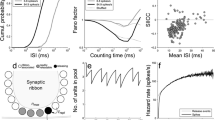Summary
The primary auditory “cortex”, field L, of the Guinea fowl is a three layer tonotopically organized structure. Isofrequency planes as shown with the 2-deoxyglucose (2 DG) method cut across these layers and with their second dimension extend in rostro-caudal direction. The input layer L2 exhibits “spontaneous” labeling due to high spontaneous activity of input terminals and units throughout the hearing range. The labeling is stronger locally along a rostro-caudal isofrequency contour of L2 after tone or narrow band FM stimulation. With tone stimuli the layers L1 and L3 are labeled within an isofrequency plane except for the rostral half of the field whereas frequency modulated tones do label these two layers throughout the corresponding isofrequency plane. FM stimuli in addition lead to a reduction of spontaneous labeling in frequency planes adjacent to those which are covered by the stimuli. Since these effects correlate with known inhibitory effects of such stimuli it is argued that the 2 DG method can identify the suppression of activity of neurons in suitable structures.
Similar content being viewed by others
References
Aitkin LM (1976) Tonotopic organization at higher levels of the auditory pathway. Int Rev Physiol 10: 249–279
Bonke BA, Bonke D, Scheich H (1979a) Connectivity of the auditory forebrain nuclei in the Guinea fowl (Numida meleagris). Cell Tissue Res 200: 101–121
Bonke D, Scheich H, Langner G (1979b) Responsiveness of units in the auditory neostriatum of the Guinea fowl (Numida meleagris) to species-specific calls and synthetic stimuli. I. Tonotopy and functional zones. J Comp Physiol 132: 243–255
Evans EF, Whitfield IC (1964) Classification of unit responses in the auditory cortex of unanesthetized and unrestrained cat. J Physiol (Lond) 171: 476–493
Goldstein MH, Abeles M (1975) Single unit activity of the auditory cortex. In: Keidel WD, Neff WD (eds) Handbook of sensory physiology, vol V/2. Springer, Berlin Heidelberg New York, pp 199–218
Leppelsack HJ (1974) Funktionelle Eigenschaften der Hörbahn im Feld L des Neostriatum caudale des Staren (Sturnus vulgaris L., Aves). J Comp Physiol 88: 271–320
Manley GA (1971) Some aspects of the evolution of hearing in vertebrates. Nature 230: 506–509
Merzenich MM, Kaas JH, Roth GL (1976) Auditory cortex in the grey squirrel. Tonotopic organization and architectonic fields. J Comp Neurol 166: 387–402
Sargent Jones L, Disterhoft JF (1979) Visualizing the rabbit auditory pathway with 14-C-2-deoxyglucose. Soc Neurosci Abstr 5: 23
Scheich H (1977) Central processing of complex sounds and feature analysis. In: Bullock TH (ed) Dahlem workshop on recognition of complex acoustic signals. Dahlem Konferenzen, Berlin, pp 161–182
Scheich H (1979) Common principles of organization in the central auditory pathway of vertebrates. Verh Dtsch Zool Ges 72: 155–166
Scheich H, Bonke BA, Bonke D, Langner G (1979a) Functional organization of some auditory nuclei in the Guinea fowl demonstrated by the 2-deoxyglucose technique. Cell Tissue Res 204: 17–27
Scheich H, Bonke D, Langner G (1979b) Tonotopy and analysis of wide-band calls in field L of the Guinea fowl. Exp Brain Res [Suppl] 2: 94–109
Scheich H, Langner G, Bonke D (1979c) Responsiveness of units in the auditory neostriatum of the Guinea fowl (Numida meleagris) to species-specific calls and synthetic stimuli. II. Discrimination of iambus-like calls. J Comp Physiol 132: 257–276
Sharp FS, Kilduff TS (1981) The 2-deoxyglucose neuroanatomical mapping technique. TINS 4: 144–148
Sokoloff L, Reivich M, Patlak CS, Pettigrew KD, Des Rosiers M, Kennedy N (1974) The [14C] deoxyglucose method for the quantitative determination of local cerebral glucose consumption. Trans Am Soc Neurochem 5: 85
Suga N (1965) Functional properties of auditory neurons in the cortex of echo-locating bats. J Physiol (Lond) 181: 671–700
Suga N, O'Neill WE (1979) Neural axis representing target range in the auditory cortex of the mustache bat. Science 206: 351–353
Suga N, O'Neill WE, Manabe T (1978) Cortical neurons sensitive to combinations of information bearing elements of biosonar signals in the mustache bat. Science 200: 778–781
Webster WR, Serviere J, Batini C, Laplante S (1978) Autoradiographic demonstration with 2-[14C] deoxyglucose of frequency selectivity in the auditory system of rats under conditions of functional activity. Neurosci Lett 10: 43–48
Author information
Authors and Affiliations
Additional information
Supported by the DFG, SFB 45
Rights and permissions
About this article
Cite this article
Scheich, H., Bonke, B.A. Tone-Versus FM-Induced patterns of excitation and suppression in the 14-C-2-Deoxyglucose labeled auditory “Cortex” of the Guinea fowl. Exp Brain Res 44, 445–449 (1981). https://doi.org/10.1007/BF00238839
Received:
Accepted:
Issue Date:
DOI: https://doi.org/10.1007/BF00238839



